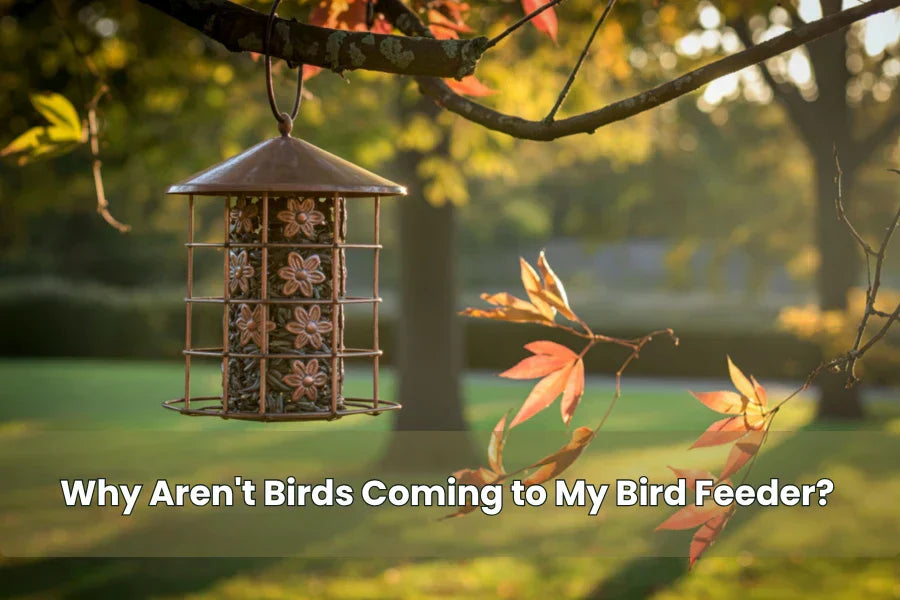Bird Vision Explained: What Makes It So Unique?
Birds have been credited with remarkable eyesight, surpassing most animals and even man. These are unique for their ability to assist them in seeing and locating food. Sight is one of the senses through which most birds depend for activities such as foraging for food, evading dangers, and even in their migratory movements. Some birds have evolved the ability to view objects at ultraviolet light; there are even birds with almost 360 vision, and such things indeed give them an edge when competing for survival in the wild.
From eagles with binocular vision to owls with excellent night vision, each bird's eye is adapted to suit the bird's requirements. This article outlines how avian vision works, how it varies from species to species, about environmental conditions, and even how it relates to what an avian being would see compared to human beings.
What Kind Of Vision Do Birds Have?
Compared to most animals, birds have very sharp vision. Their eyes are relatively larger than the head, giving the animals a large field of vision. Most birds are known to have lateral vision, where their eyes are located on the end of the head. This enables them to track the presence of a predator or prey easily and without much compromise on their accuracy. Birds also see more color than humans; they can detect ultraviolet light to identify food and movement within a specific area.
What Birds Have 360 Degree Vision?
Some bird species have developed an almost circular field of view, which helps them notice a threat from any side. There is the woodcock and the pigeon, which have nearly a 360-degree field of vision. These birds have tiny eyes set rather far apart from one another, and thus, they can practically see in circles while turning their heads only a little, which is of great help in the wild.
What Birds Have 180 Degree Vision?
180-degree vision is essential for hunting since the birds must catch sight of the prey and aim at the depth of the scope. Eagles, hawks, and owls can see at this degree. The forward-facing eyes give them an exact focal plane, enabling them to have a sharp vision of the object to capture it either in flight or on the ground.
Why Do Birds Need Good Vision?
Vision is also paramount to birds when hunting, flying, and escaping predators. It enables them to move from one environment to another, locate food sources, and evade dangerous animals or other forms of danger. Furthermore, some birds are migratory, and their eyesight enables them to utilize some direction and follow some visual guidance as they travel between breeding and feeding grounds.
What Bird Has Best Vision?
So, you are one of them asking this question; what bird has the sharpest vision? Eagles have some of the best eyesight among birds and other animals. Their sight is said to be 4 to 8 times that of humans. From observing their behavior, it is clear that they can see a rabbit from several miles away and describe the animal's location with much precision before pouncing on it. This gives them sharp vision, especially when hunting at long ranges.
What Bird Has The Worst Vision?
Which bird has the worst eyesight? While most avian groups exhibit outstanding vision, others have rather poor vision. Kiwi birds are said to possess a feeble sense of sight. This means these birds are active at night and depend more on olfactory and factorial organs in search of food in the dense forests on the ground. Eyes are comparatively small, and there is a general lack of vision, which is quite sharp in other birds, vision being one of the weakest in the avian kingdom.

Can Birds See In The Dark?
Birds normally have low nocturnal vision compared to other animals, such as cats. However, some animals, such as owls, can be seen at night. Compared to other birds, owls have big eyes, which facilitate the receipt of more light and their nocturnal hunting. Their retinas are also filled with rod cells, which provide a means to see in the dark, which is why they are active during the night.
What Birds Have The Best Night Vision?
Owls are some of the best-adapted birds for seeing at night. They possess unique and presumably highly developed eyes that allow them to perceive their surroundings, to all intents and purposes, in complete darkness. These animals have large corneas and pupils, so they take in as much light as they can, and their retina has many rod cells, which work in very low amounts of light. It makes it possible for them to hunt during the night.
Hence, if you are now questioning, are birds afraid of darkness? Though they usually don't like the dark, birds are more prone to danger at night. A lot of birds sleep at night, looking for protected areas to stay away from predators. Nonetheless, some animals, such as nightjars and owls, are nocturnal and do well in the dark, making it easy for them to hunt and navigate.
What Colors Can Birds See?
Birds possess the ability to have a vision that is more extended than that of human beings. They are also sensitive to ultraviolet light and the human eye's three colors: red, green, and blue. This extra range of color vision aids in several functions, including finding ripe fruits, detecting animals and birds, and picking the right partner based on the brightness of their feathers that can reflect ultraviolet rays. This is a necessity for survival due to the increased perception of color.
How Do Birds See Humans?
Contrary to what most people believe, birds have a way of perceiving humans and their actions. As a result, they perceive more details, such as differences in colors and movement. Occasionally, birds may even see the visible light reflected from the human skin or their clothing. This means they can see humans coming from a far distance and act appropriately, which most often involves flying away or camouflaging.
Can Birds Sleep If There Is Light?
Birds can sleep with some degree of light. However, they prefer darkness to some extent, particularly nocturnal birds. When it comes to diurnal birds, there aren't many issues with the sort of light to which they are exposed. Another is that they can sleep with one eye open to any danger. However, they also have to deal with artificial light at night, which, if excessive, can interfere with their sleeping pattern.
Can Birds See Glass?
Can birds see mirrors? Most birds do not recognize the glass as a barrier; they cannot see it, so they crash into it unknowingly. Glass is clear, and birds certainly cannot first tell the difference between fresh air and the invisible surface of the glass. The same applies to other animals, where birds, for instance, can see reflections in water but can hardly understand that they are reflecting themselves. Some birds, like the robins and the cardinals, usually attack the reflection because they consider it an intruder in their territory.
Can Birds Look At The Sun?
Yes, birds can gaze at the sun, and certain species of birds, such as eagles, have special provisions that would not harm their vision. They have a third tiny eyelid called a nictitating membrane that filters UV light from the sun, allowing them to fly or hunt during the day.
Do Birds Have Ultraviolet Vision?
Birds are indeed able, to some extent, to see ultraviolet or UV light. Many bird species can see UV light, which provides them with certain benefits in activities such as foraging, mate selection, or orientation. It also takes longer to digest food, and some birds' feathers glow in ultraviolet light, making them irresistible to the opposite gender.
Bird With Binocular Vision
What is bird binocular vision? The capacity to view an item with both eyes open simultaneously is known as binocular vision. Predatory birds, such as owls, falcons, and eagles, have binocular vision. Their eyes are oriented forward, enabling them to locate distances conveniently, making them good hunters. This vision provides increased focal distance, meaning birds can view and capture hunts from far distances.
Bird Vision Vs Human Vision
Birds and humans perceive the world in quite a different manner, for instance, in the manner in which they locate their food. Because birds' eyes are spaced out at various parts of their heads, they have a much wider range of peripheral vision than humans. Some birds can have their peripheral vision slightly above 360 degrees, and humans' is approximately 180 degrees.
Also, birds have more developed vision than humans; they can see more colors, including ultraviolet light, which allows them to see objects or prey that a human eye cannot even see. To address the needs of birds, modern humans use color and movement, although they pay great attention to detail.

Do All Birds Have Good Vision?
Not all birds possess good vision, though some have sharper vision than others with lesser vision. Some birds, although they have excellent vision, such as the birds of prey, like the kiwis, have comparatively poor vision, as do some waterfowl. It is also considered that the nocturnal birds possess comparatively low vision conditions in the bright daylight.
Species' ability to see also varies with the needs of different species depending on their habitat and circumstances. For example, if a bird feeds on scents or sounds, it can be of little relevance to its survival to be endowed with incredibly sharp vision.
Conclusion
Among animal species, birds are some of the most efficient creatures that rely on vision systems to survive in various habitats. Even though not all birds have developed senses of vision, most of them use their eyes to scan for dangers, hunt for food, or maneuver in their environment. Studying bird vision contributes to knowledge about how birds perceive the world and how they behave to survive.
Share





























